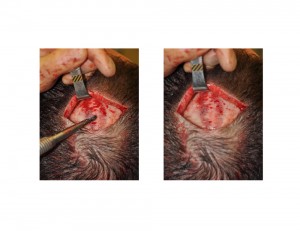One of the most common of all aesthetic raised skull deformities is that of the sagittal ridge. As a result of the fusion of the midline sagittal suture, bone thickening can occur between the original anterior and posterior fontanelles. In its fullest expression such sagittal suture fusion becomes a craniosynostosis. But there are numerous smaller or incomplete versions of craniosynostosis where only a raised ridge of bone occurs down the middle of the skull without causing a lengthening of the skull from front to back or any significant transverse narrowing.


An important question to answer before this type of skull reshaping surgery is how thick is the sagittal ridge and how much can it be reduced. This can be quantitatively determined before surgery with a 3D CT scan where the bone thickness can be measured if there isn any doubt as to its thickness. When burring down the ridge it is common, particularly in the back, to encounter large bone bleeders and these are effectively obliterated with bone wax. When the color of the midline bone starts to become a faint blue in color, it is time to stop as the inner cortex is getting thin. Usually up to 7mms of crestal bone can be reduced.
Dr. Barry Eppley
Indianapolis, Indiana


